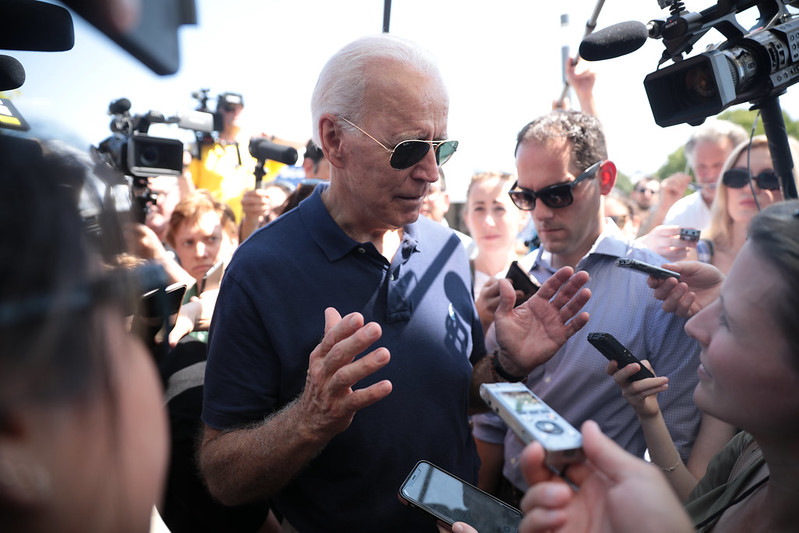Joe Biden swept Florida, Illinois, and Arizona on Tuesday, jumping ahead to 1,173 of the 1,991 delegates he needs to win the presidential nomination. Very few voters have the stomach for more intra-party squabbling and a “team of rivals” becomes a more likely outcome of the competition.

Bernie Sanders’s campaign is running on borrowed time.
He has lost the attention of a public pre-occupied with the greatest health crisis of our generation, if not our lifetimes, as well as any path to win the Democratic presidential nomination.
Concerns about COVID-19 caused confusion and postponement of in-person voting in Ohio, and disarray in the Florida, Illinois, and Arizona primaries. Making things worse, the schedule for the remaining Democratic primaries is in shambles. Georgia has postponed its March 24 primary until May 19, Louisiana has delayed its April 4 primary until June, Kentucky is moving its May primary until late June, and Maryland is shifting its April 28 primary to June 2, the Wall Street Journal reported.
Democrats fervently want to see President Trump defeated, but like everyone else, they have immediate concerns about elderly and vulnerable relatives and about themselves. At this point, few have the stomach for more intra-party squabbling.
Joe Biden swept Florida, Illinois, and Arizona on Tuesday in the Democratic primaries, jumping ahead to 1,173 of the 1,991 delegates he needs to win the Democratic presidential nomination at the Milwaukee convention in July, while Sanders fell further behind with 884, according to Green Papers.
The Turnout Question
Sanders had his best showing in Arizona, which is important because it could go either way in the Nov. 3 general election, and exit polls appeared to show nearly one in five of his supporters preferred someone they agreed with over a winner. Sample sizes were small for such cross-tabulations but it does raise a question—will those people show up to vote for Biden?
For all that, the race was pushed aside by the pandemic. The numbers at the top of the Los Angeles Times, 471 and 19, were for confirmed COVID-19 cases and deaths in California. The New York Times and Washington Post relegated the political story down the page from the pandemic.
Further confusing matters, Russia is reportedly planting false and misleading social media posts about the pandemic, the same techniques it used to influence the 2016 election.

The Democratic Dream
It is time to move on. Newspapers have reported that pressure is mounting on Sanders to drop out and quoted Biden’s talk of a “common vision” with him. Anticipation is so high that Axios reported Sanders had dropped out, then had to issue a correction.
What a number of commentators want now is the Democratic Dream, which would begin with a joint press conference by Sanders and Biden. Sanders would announce he was withdrawing to endorse Biden, who had agreed to adopt some of his ideas. Biden would graciously accept the endorsement, talk about the importance of Sanders’s ideas and promise to do all in his power to make them happen.
Biden would also announce Sanders would be a member of his cabinet. In the version of the Democratic Dream by New York Times opinion columnist Thomas Friedman, Sanders might be Treasury Secretary.
Team of Rivals
Friedman suggested that Biden (actually, he said “the nominee” because Biden was not then the front-runner) should announce his entire cabinet and his vice president immediately, drawing them from his opponents—a team of rivals. Biden has said he will choose a woman for vice president, and some say she should be a black woman.
If Biden takes Friedman’s advice, it will multiply the power of his surrogates on the campaign trail.
One can imagine Pete Buttigieg campaigning vigorously for Biden in some part of the country, and part of his stump speech is “If you vote for Joe Biden for president, you will be getting me as Director of Homeland Security and Elizabeth Warren as Secretary of State. You are voting for an entire team.”
This unity is something desired by Democrats, except perhaps for some bitter Sanders supporters who have vowed to sit out the race if Sanders is not the nominee. That does not necessarily spell defeat, as President Harry Truman found in 1948 when he faced two splinter candidates, Henry Wallace on the left and Strom Thurmond speaking for southern segregationists.
Usually, the Truman surprise is trotted out by candidates who are in trouble, but in this case, that is not necessarily true and the key job of the Democrats will be to turn out Independents and Democrats at the polls in November.
The question now is how to do that. It starts by Democrats joining together.
David Lawsky covered presidential elections through the year 2000 and was the delegate counter for UPI in 1984, when his count was preferred by most news organizations. Lawsky also worked for two decades as a journalist for Reuters in Washington, Brussels, and San Francisco.
The ProMarket blog is dedicated to discussing how competition tends to be subverted by special interests. The posts represent the opinions of their writers, not necessarily those of the University of Chicago, the Booth School of Business, or its faculty. For more information, please visit ProMarket Blog Policy.





